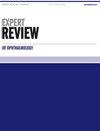2型糖尿病患者干眼症相关的生活质量:一项基于医院的横断面研究
IF 0.9
Q4 OPHTHALMOLOGY
引用次数: 0
摘要
摘要背景研究干眼综合征(DES)对2型糖尿病患者干眼相关生活质量(QoL)的影响。DES的研究设计和方法评估包括评估睑板腺功能、撕裂时间(TBUT)、Schirmer试验、荧光素眼表染色和眼表疾病指数(OSDI)评分。DES的诊断基于OSDI评分≥13,TBUT<10s和荧光素染色。结果在调整了年龄、糖尿病持续时间、药物使用和合并症后,与对照组相比,DES症状和体征的严重程度导致患者的生活质量较差。TBUT、眉骨质量和眼表染色是与生活质量显著相关的客观临床测试。生活质量差也与睫毛和眼睑异常有关(睫毛:aOR=2.58,CI=1.49-4.47,p=0.001;眼睑:aOR=1.66,CI=1.01-2.71,p=0.04)。先前诊断和治疗DES的患者的生活质量指标有所改善。结论DES的症状或临床体征导致2型糖尿病患者的生活质量较差,强调临床医生需要评估这些症状和体征以改善生活质量。本文章由计算机程序翻译,如有差异,请以英文原文为准。
Dry eye-related quality of life among type 2 diabetes patients: a hospital-based cross-sectional study
ABSTRACT Background To investigate the impact of dry eye syndrome (DES) on dry eye-related quality of life (QoL) in patients with type 2 diabetes. Research design and methods Evaluation of DES included assessment of meibomian gland function, tear breakup time (TBUT), Schirmer test, fluorescein ocular surface staining, and Ocular Surface Disease Index (OSDI) scores. DES diagnosis was based on OSDI score ≥13, TBUT < 10s, and fluorescein staining. Results After adjusting for age, duration of diabetes, drug usage, and comorbidities, severity of DES symptomatology and signs resulted in poorer QoL of patients when comparing cases and controls. TBUT, meibum quality, and ocular surface staining were the objective clinical tests that significantly correlated with QoL. Poor QoL was also associated with the presence of eyelash and eyelid anomalies (eyelash: aOR = 2.58, CI = 1.49–4.47, p = 0.001; eyelids: aOR = 1.66, CI = 1.01–2.71, p = 0.04). Patients who had been previously diagnosed and treated for DES registered improved QoL measures. Conclusions Symptoms or clinical signs of DES resulted in poorer QoL in a clinical sample of type 2 diabetes patients, stressing the need for clinicians to evaluate such signs and symptoms in order to improve QoL.
求助全文
通过发布文献求助,成功后即可免费获取论文全文。
去求助
来源期刊

Expert Review of Ophthalmology
Health Professions-Optometry
CiteScore
1.40
自引率
0.00%
发文量
39
期刊介绍:
The worldwide problem of visual impairment is set to increase, as we are seeing increased longevity in developed countries. This will produce a crisis in vision care unless concerted action is taken. The substantial value that ophthalmic interventions confer to patients with eye diseases has led to intense research efforts in this area in recent years, with corresponding improvements in treatment, ophthalmic instrumentation and surgical techniques. As a result, the future for ophthalmology holds great promise as further exciting and innovative developments unfold.
 求助内容:
求助内容: 应助结果提醒方式:
应助结果提醒方式:


